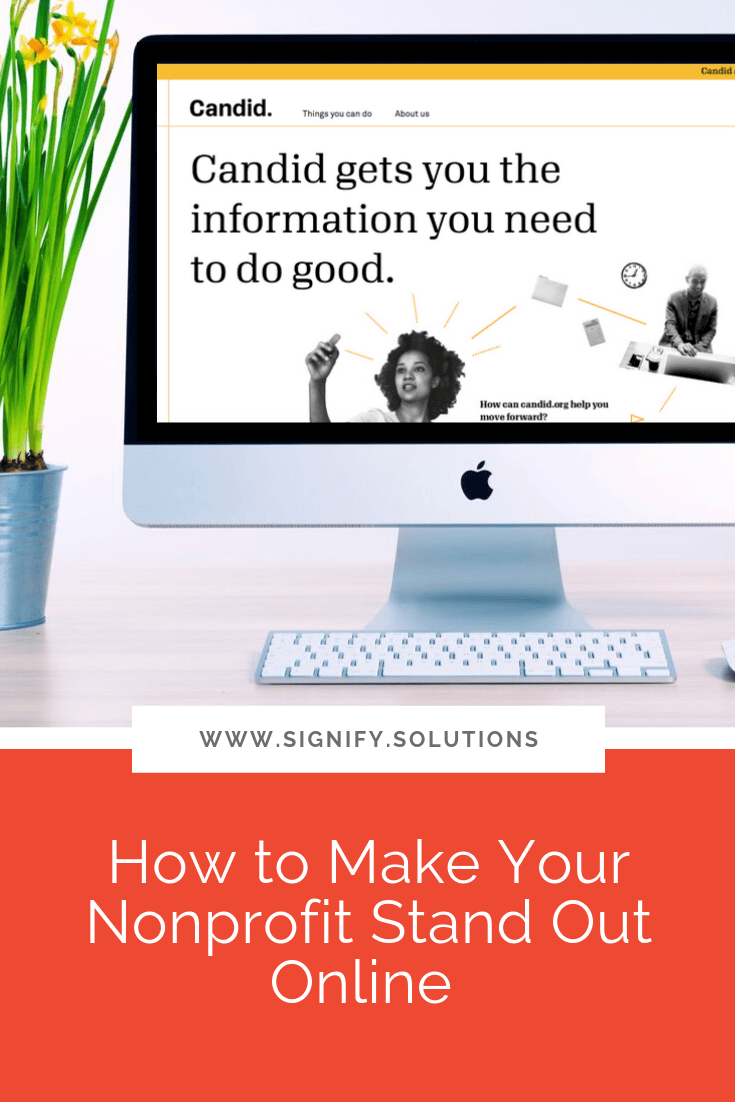Outside of your people, your website is your nonprofit or social enterprise’s greatest marketing asset. It’s also one of the most important tools you have to help you make a bigger social impact. In fact, it’s so important that we’re going to look at it from just about every angle.
From what you should do before you create or update your website, to writing and designing it, to how to promote it after going live, this is your ultimate guide to social impact websites.
It’s time to build and engage a larger audience, increase your sales or donations, and do more good. This is one tool to help you do just that.
Programming note: Because this is such an important topic, we’ll be talking about social enterprise and nonprofit websites for the next couple of months. As the blog gets updated, this post will be expanded as well.
Below you’ll find some of our favorite topics to think about when it comes to social impact websites. Whether you’re starting from scratch or updating your site, this information will help you take the next, right step.
Before You Begin Working on Your Social Impact Website
Why Your Social Impact Mission Isn't Enough
For your mission to not only engage the right people, but compel them to act, you need to ensure that you have a clearly defined brand message and brand voice. You may think of your “brand” as only part of your marketing, but your brand informs what you say, how you say it, and what your mission looks like visually. It’s essential to every aspect of your organization.
Benefits of a Nonprofit Brand Voice Guide
Wouldn’t it be great if your donors gave you more money? And new donors were easier to attract and engage? There will certainly be times when donors change their giving priorities, don’t connect with the mission, or the timing is just off, but there are other times when it’s possible that we confuse them with our message or don’t give them a clear plan to act. So, what’s the best way to help donors understand and respond to your needs?
Know Your Audience
Knowing your audience determines how you communicate your message. Whether you’re talking about your website overall, or individual pages, it’s important to think about the reader first. Consider both the “who” and the “how”.
3 Exercises for Evaluating Your Brand Story
Your brand story is the narrative that you use to describe your organization and how it came to be, who you serve and how you serve them, goals for the future, what you stand for, and even the emotions that your mission makes people feel. Your brand story is what helps people decide if they want to take the next step with you.
WEBSITE PLATFORM ADVICE
Squarespace: The Pros and Cons
No website platform is perfect, but I’ve been very happy with Squarespace. Madison Beaulieu, half of the dynamic duo that created Signify’s website, breaks down the most important things you need to know about this option.
WordPress: The Pros and Cons
Alison Chandler is one of my go-to designers. In this post, she highlights why about 30% of the websites in world are hosted on Wordpress, and why it may be a good option for you.
OVERALL TWEAKS For Your Nonprofit website
The Small Nonprofit Podcast: 10 Steps to Upgrading Your Website
Listen to my friend, Cindy Wagman, and I discuss the importance of nonprofit websites, how they contribute to your nonprofit’s marketing, and some tweaks you can make to improve your site quickly and efficiently.
DESIGN AND VISUAL BRANDING
Ask the Experts: Design and Branding for Social Impact Organizations
As a copywriter, I love talking words. But, in order to serve you well, I can’t ignore the visual side of your marketing and communications. So, when it comes to design and branding for social impact organizations, I can dish out some pretty good advice, but my secret weapon is the company I keep—including Jaci Lund of Treebird Branding.
Ask the Experts: Branding and Design for Nonprofits and Social Enterprises
I get complements on my website and visual branding all the time, and that’s thanks to Madison and Dusty Beaulieu. Madison wrote this post, and I love how she breaks down some important design topics that often trip people up.
Want Your Social Impact Website to Look Good? Start Here.
Does your nonprofit or social enterprise website look like it’s worthy of the dollars you’re asking people for, or does it look like you’re still trying to get your act together? Let’s talk about a simple tool that will help you look like a million bucks (even if you aren’t). Without it, your organization can unknowingly communicate that you’re an amateur.
Copywriting FOR NONPROFITS AND SOCIAL ENTERPRISES
4 Tips for How to Become a Better Writer
As a copywriter with almost two decades of experience, one of the questions I get asked a lot is how to become a better writer. From grant proposals to product descriptions to blog posts to websites and more, you have a lot to say, and it needs to be said well in order to gain more support for your nonprofit or social enterprise. Learning how to convince and compel with the written word is not just an essential skill, but one that stands the test of time.
Advice From The Editors: Avoid These Writing Mistakes
I asked a few of my favorite editors to explain some common writing mistakes, which will allow you to spot any weaknesses you may have, and improve them. (Basically, here's how you can up your writing game in just a few minutes!) Any corrections you can catch now may cause you to not only improve your marketing, but retain customers and donors in the future.
7 Tips You Need to Know to Write a Better Website
Designing and writing content for your website can seem challenging, but my former intern, Megan Westbrook, is going to walk you through the most important, and sometimes overlooked, aspects that will make your website effective, navigable, and memorable.
How to Rewrite Your Website in One Week
In this guest post for Candid (formerly Foundation Center and Grantspace), I outlined a simple process for rewriting your website in one week. Though written to nonprofits, anyone can make good use of this process. It’s an audacious goal, I know, but if you’re short on time and highly determined, you can make it happen!
Why The Words On Your Site Matter As Much As the Design
In this guest post, I emphasize why you should not only consider the look of your website, but what it says. I also give you a few tips on how to make the copy (<— the words on your site) even better. And, yes, there are some budget-friendly options!
Marketing Must-Haves
8 Creative Ways to Gain More Email Subscribers
Between all the blogs, online shops, and websites, all of our inboxes are already crowded with marketing emails asking for sales and donations, and the old classic “Sign up for my newsletter!” call to action just isn’t cutting it anymore. Here are eight creative alternative ways to get new email subscribers and not get sent to spam.
NONPROFIT CONTENT MUST-HAVES
5 Donor Communication Essentials
No matter what type of donor you are talking to, nonprofits need to consistently communicate with donors, while at the same time targeting the specific message that prompted the donor to initially become engaged. Keeping everyone informed may very well graduate them from one level of supporter to another. Thanks to Amy Crowell for this post!
BLOGGING FOR SOCIAL IMPACT ORGANIZATIONS
4 Ways to Help Donors and Customers Find Your Social Impact Mission on Google
Now that the initial excitement of your nonprofit or social enterprise launch has worn off, your website isn't getting as many clicks as you’d like and it seems that all your marketing efforts are falling flat. You know that you have the power to change lives, but people just aren’t finding you. What if I told you there’s a way to help more people find your amazing cause online?
5+ Reasons Why No One is Reading Your Blog
Does this sound familiar: Someone lands on your little labor of love, maybe skims a little, and then promptly leaves. Here you find yourself with a blog post that took precious time and energy, but didn't actually get the job done. It's finished, but it's not effective. Here are a few blog writing tips that will help ensure your post gets read, and better yet, acted on.
How to Generate and Organize Content for Your Blog
Blogging is the “meat and potatoes” of the internet right now and, if it’s not already, it should be an important tool in your content marketing tool belt. Blogging builds your audience, brand image, and increases your visibility on the internet. It’s also a very easy and practical way to show off your expertise. Check out this advice from former intern, Michael Banks, on how to revamp your organization’s blog, and make it a regular part of your social enterprise or nonprofit marketing strategy.
Should Your Nonprofit Have a Blog?
Blogs seem to be a particular pain point for nonprofits. There is either pressure to create the content (and resentment when it doesn’t happen), or so much overwhelm with regular responsibilities that a blog never gets off the ground. So, what are you to do?
12 Questions That Inspire Content Creation
You know you should be reaching out to your audience on a regular basis, but you’re just not sure what to say. It’s a common problem, and one I get asked about a lot. Coming up with a constant stream of topics can be daunting, especially with everything else on your plate. So, where can you find inspiration at any given moment—especially when you’re not feeling it?
Outsourcing Your Website COPYWRITING OR DESIGN
Should You Invest in a Copywriter For Your Nonprofit Website?
Do you actually need a copywriter for your nonprofit website? If you’re creating your first site, or relaunching a new one, this question may have already popped into your head. And just because I’m a copywriter that specializes in nonprofits, social enterprises, and social impact companies, my answer is not going to be an automatic, “Yes.”
Why Free Help Isn't Always the Best Option
Just because someone offers to help you write or design your website for free doesn’t mean you should take them up on the offer. Let me explain why.
Want to Grow Your Nonprofit or Social Enterprise? You Need Help.
It's not easy to decide to spend the money, allocate your resources differently, or bring someone new into your process. But I believe this one decision can make all the difference. And guess what? It may not even require hiring more staff.
Legal Considerations For Your Website
2 Simple Ways to Keep Your Website and Work Protected
While this may not be the most exciting topic to discuss, it’s super important! You need to protect the time, money, and effort you’ve put into your website. Besides, you have your mission to think about, not to mention the secret sauce of the way you work. There’s also any proprietary photography and other assets. It’s all those details that add up to your beautiful and unique brand. Let attorney Christina Scalera explain why you shouldn’t leave your website unprotected.
Promoting Your New Social Impact Website
Signify’s Launch Marketing Checklist
Having a beautiful, new website isn’t the final step. At the end of the process, you should promote the gorgeous thing to your donors, customers, and key stakeholders. This checklist has pages of marketing ideas for exactly how you can share your big news.
How to Make Time for Marketing
Need to promote your new website, but always find that something else takes priority? Here are four of my favorite ways to make your marketing actually happen.
Get Found on Google
My friend, Meg Casebolt, can teach your nonprofit or social impact company how to get found on Google through SEO (Search Engine Optimization). Though SEO can get pretty complicated, Meg is a patient and caring teacher, and shows beginners how to become pros through simple and strategic steps. I want you to have a terrific website, but I also want your website to get found by the right customers and donors.
Learn about Attract & Activate . . .
We’ll be posting a lot more about nonprofit, social enterprise, and social impact websites over the next few months, and will update this post along the way. Stay tuned!
PIN THIS POST FOR LATER:
I’m Kristi Porter, and I help cause-focused organizations understand and execute effective marketing campaigns so they can move from stressed to strategic. Your resources may be limited, but your potential isn’t. Whether you’re a nonprofit, social enterprise, or small business who wants to give back, I’ll show you how to have a bigger impact.







































